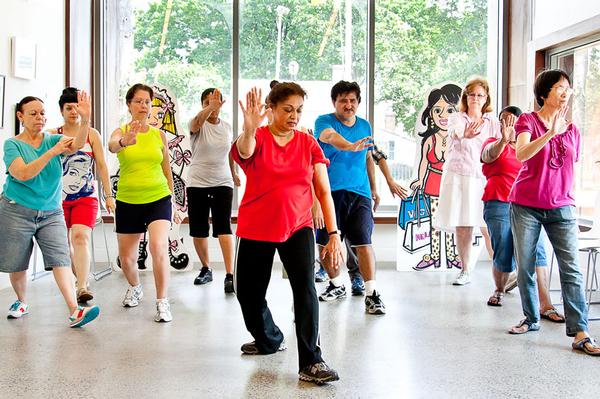
Photo by: Adi Talwar
Primwatee Maharaj Groover Teaching Tai Chi at the Poe Park Visitor Center in the Bronx, July 19, 2013.
In its recent five-year report, the city’s Department of Health and Mental Hygiene informs Bronxites of progress. There has, for instance, been a welcome decline of rats in properties where they were much too present.
But there an ongoing health crisis in the borough, and it’s stated clearly: “The Bronx, in particular, is facing an obesity crisis, with 65 percent of adults — almost 631,000 residents — currently overweight or obese.”
That’s almost half of the borough’s population — 1.4 million — and doesn’t even include overweight or obese kids.
South Bronx kids, in particular, are more likely to be overweight than those in the city as a whole with nearly one-in-four public elementary school children obese (grossly overweight), and nearly four in 10 overweight or obese, according to “Obesity in the South Bronx,” a Health Department report.
So what’s being done?
In its report, the Health Department catalogs its efforts to reduce obesity. It cites the 500 Green Cart permits it has issued since 2008 allowing vendors to sell vegetables and fruits in underserved communities, as well as 1,300 city-contracted vending machines with healthier products.
The city tried to decrease the size of sugary drinks sold in larger markets but a court overrode their efforts. So the department “continues to pursue unique strategies to decrease sugary drink consumption, and through these efforts declines in sugar-sweetened beverage consumption have surpassed targets,” the report says.
But there are other obstacles besides soda to Bronxites getting healthier.
A particular problem is the lack of play space as modular classrooms often take up Bronx school yards. And there’s a lack of sufficient time and staff for all school-kids to take part in regular exercise. Although state regulations require physical education for two hours a week in schools, there are “so many barriers to them being able to do that,” says Kelly Moltzen, Healthy Schools NY program coordinator at Bronx Health REACH. There are not nearly a sufficient number of phys ed teachers per school, she adds, and in many buildings—particularly high schools that are home to several schools—there is less space for gyms.
“If [schools] are lucky, they provide one day a week, [about] 40 minutes,” said Amy Schwartz of the Women’s City Club of New York, which is leading efforts to take the issue of physical education access to the City Council. “Not only did no schools meet the mandate and very few principals knew there was a mandate.” Schwartz notes that an audit Comptroller John Liu found the DOE had not updated its phys-ed plan in over 20 years. And she adds that physical education isn’t just about getting the heart rate up and the body weight down; it helps kids learn. “We also argue that it’s very well documented — there are big reports — that if you get more phys-ed classes, kids will do better academically,” she says.
The Women’s City Club wants a City Council hearing to move the issue forward. A few current Council members support that, but it’s unclear whether it will occur during the final weeks of Bloomberg’s mayoralty, or be taken up by the new mayor and Council.
Meanwhile in the Bronx, the Department of Health is collaborating with borough community groups and partners to address the borough’s serious obesity issues.
“We are trying to pull together a partnership of borough stakeholders,” says Jane Bedell, an assistant health commissioner based in the Bronx. “And the idea is that together, much like the mayor’s obesity task force, we set out some goals for the Bronx.”








